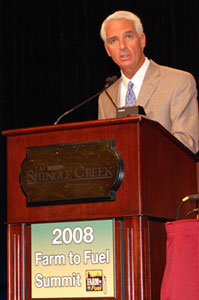 Oklahoma might be famously known for its “winds that come sweepin’ down the plains,” and one of the leading universities in the state is going to put that to work.
Oklahoma might be famously known for its “winds that come sweepin’ down the plains,” and one of the leading universities in the state is going to put that to work.
The Oklahoma City Oklahoman reports officials with the University of Oklahoma in Norman have inked a deal with Oklahoma Gas and Electric to buy nothing but wind power for the campus by the year 2013… a significant increase over the 10 percent wind power the school uses now:
[OU President David] Boren said the switch will cost about $60,000 in initial surcharges, but the university could end up breaking even or making a profit by selling carbon credits on the Chicago Climate Exchange and participating in investment funds with OG&E.
 “It is our patriotic duty as Americans to help our country achieve energy independence,” Boren said at a news conference at OU. “We should become a national role model for the environment.”
“It is our patriotic duty as Americans to help our country achieve energy independence,” Boren said at a news conference at OU. “We should become a national role model for the environment.”
Boren said OU would be the nation’s largest public college to convert to renewable energy.
The deal is dependent on a new wind farm going up near Woodward, OK and about 140 miles worth of transmission lines to carry the power to Oklahoma City… both of which still to be approved by the state’s Corporation Commission.



 This week, Belgian professor and so-called United Nations “expert” Olivier de Schutter tried to blame the rise in food prices on biofuels. But Jobe fought back with the best weapon available:
This week, Belgian professor and so-called United Nations “expert” Olivier de Schutter tried to blame the rise in food prices on biofuels. But Jobe fought back with the best weapon available:  While the soaring price of oil is overwhelmingly recognized as the major factor driving food price increases, biofuels such as ethanol and biodiesel have had a marginal effect on the increase in food prices in the U.S. – about four to five percent – according to the U.S. Department of Energy and the USDA.
While the soaring price of oil is overwhelmingly recognized as the major factor driving food price increases, biofuels such as ethanol and biodiesel have had a marginal effect on the increase in food prices in the U.S. – about four to five percent – according to the U.S. Department of Energy and the USDA. Jenna Higgins Rose, the friendly communications director at NBB, gave me the “nickel tour” (although it didn’t cost a dime!) of their new digs. That’s Jenna on the right, showing me the new conference room with a state-of the art video conferencing system with the NBB’s office in Washington, DC (that’s a picture of the DC office on the screen). This is just one example of how the good folks at NBB are really practicing what they preach. Doing a conference over a video conference saves them not only thousands of dollars and many hours of travel time, but they greatly reduce their carbon footprint by not burning the fuel needed to fly to the various locations that this truly national organization covers.
Jenna Higgins Rose, the friendly communications director at NBB, gave me the “nickel tour” (although it didn’t cost a dime!) of their new digs. That’s Jenna on the right, showing me the new conference room with a state-of the art video conferencing system with the NBB’s office in Washington, DC (that’s a picture of the DC office on the screen). This is just one example of how the good folks at NBB are really practicing what they preach. Doing a conference over a video conference saves them not only thousands of dollars and many hours of travel time, but they greatly reduce their carbon footprint by not burning the fuel needed to fly to the various locations that this truly national organization covers.
 According to a
According to a  “The goal is to determine the best crop management, storage and handling practices for Georgia, and just as important, the performance of herbaceous biomass in Range Fuels’ conversion process,” said Anna Rath, Ceres vice president of commercial development. She noted that grass species, including both annuals and perennials, can provide a flexible and reliable supply of raw materials for fuel and power. “This is an important step in demonstrating that energy crops can be successfully and sustainably grown in the area surrounding the Range Fuels Soperton Plant site,” she said.
“The goal is to determine the best crop management, storage and handling practices for Georgia, and just as important, the performance of herbaceous biomass in Range Fuels’ conversion process,” said Anna Rath, Ceres vice president of commercial development. She noted that grass species, including both annuals and perennials, can provide a flexible and reliable supply of raw materials for fuel and power. “This is an important step in demonstrating that energy crops can be successfully and sustainably grown in the area surrounding the Range Fuels Soperton Plant site,” she said. Florida Governor Charlie Crist says an ethanol plant may be built on land that the state is buying from U.S. Sugar to use for Everglades restoration.
Florida Governor Charlie Crist says an ethanol plant may be built on land that the state is buying from U.S. Sugar to use for Everglades restoration. Democratic presidential candidate Barack Obama spoke to the NFU members by phone and pledged his support for new investments in renewable fuels and other policies that would benefit rural America. Obama also reiterated his support of the Renewable Fuels Standard. “I am strongly committed to advancing biofuels as a key component of reducing our dependence on foreign oil,” he told the NFU members.
Democratic presidential candidate Barack Obama spoke to the NFU members by phone and pledged his support for new investments in renewable fuels and other policies that would benefit rural America. Obama also reiterated his support of the Renewable Fuels Standard. “I am strongly committed to advancing biofuels as a key component of reducing our dependence on foreign oil,” he told the NFU members.
 San Francisco’s proposed biodiesel plant would be situated within on old rendering facility in the Hunter’s Point district owned by Darling International. Under the plan the facility will be renovated to turn grease waste into useable, sustainable energy. Although the agreement has not yet been signed, it is expected that the city will purchase the fuel to cut down on shipments from the Midwest while feeding San Francisco’s biodiesel fleet of 1,500 vehicles.
San Francisco’s proposed biodiesel plant would be situated within on old rendering facility in the Hunter’s Point district owned by Darling International. Under the plan the facility will be renovated to turn grease waste into useable, sustainable energy. Although the agreement has not yet been signed, it is expected that the city will purchase the fuel to cut down on shipments from the Midwest while feeding San Francisco’s biodiesel fleet of 1,500 vehicles. Last week,
Last week,